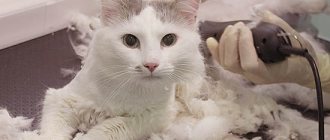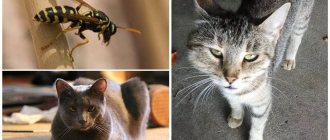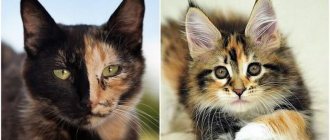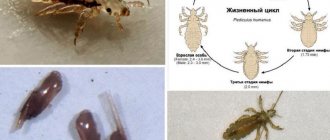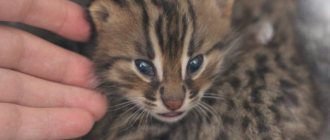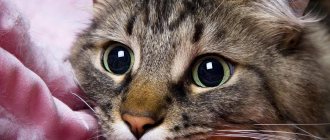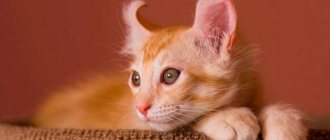Why do cats get their hair cut?
Owners who groom their cats are guided by the following reasons why they do it:
- The cat is hot in the summer, he suffers.
But the owner apparently doesn’t know that nature provides that wool protects animals not only from cold, but also from heat. A cat's coat provides thermoregulation. Cats do not sweat because they do not have sweat glands, and moisture does not evaporate from the skin, as happens, for example, in humans. The danger is that a pet without a fur coat will simply overheat in the heat and get heatstroke. The skin suffers - it is defenseless against the wind and sun.
- The cat sheds a lot.
All cats, except of course hairless ones, have a lot of hair. Therefore, during the molting period, animals are combed more often. Just because the hairs are cut off, the shedding will not stop or become less. The hairs will become shorter and almost impossible to remove from the furniture.
- I want the cat to be stylish.
An aesthetic hairstyle for beauty is more of a whim of the owner who wants to make the cat fashionable. Model haircuts for cats are given to animals in preparation for an exhibition or photo shoot.
- The cat's fur is matting.
Matted fur is an indication to shave your cat. However, if animals are cut because of mats, then this only means one thing - there is no proper care for the pet. The owner did not teach the cat to brush and bathe. Accustomed to grooming since childhood, the pet humbly endures all grooming procedures.
What does a cat owner need to know about anesthesia?
At first glance, the life of our pet is easy and pleasant: she is fed, taken care of, stroked and caressed. However, sometimes the owners come up with strange fantasies. Then suddenly they decide to wash and comb the fur, although it is already carefully licked and smoothed every day. Sometimes they take you somewhere far away, and it’s good if it’s to a dacha, otherwise you suddenly find yourself in some strange room, where there is an eerie smell, barking and meowing are heard, and someone else’s uncle in white is preparing to perform strange actions.
We suggest you read: Breeding pigeons as a business: how much can you earn?
And although the owner speaks kindly, it all looks suspicious, and most importantly, even the smartest cat in the world cannot understand why all this is needed.
How to help a cat so that this help does not become unbearable stress for her? And how can we make it possible to carry out the necessary procedures? In order to answer these questions, let's look at situations where the use of special drugs may be necessary.
This terrible word "narcosis"
In fact, another term has long been used in medical practice - “anesthesia”. General anesthesia (anesthesia itself) is a state of deep sleep of an animal with complete loss of all sensitivity. Such anesthesia is necessary for serious painful operations; it saves the animal not only from suffering, but also from death due to painful shock.
There is also local anesthesia - this is a loss of sensitivity in certain areas of the body. Local anesthesia is divided into 8 types depending on where exactly the intervention should be performed.
Horrible stories about anesthesia will be passed on from mouth to mouth by more than one generation of pet owners. Let’s say right away (have the courage to bear this “news”) - there are no completely harmless anesthesia drugs. Nowhere.
However (here you can exhale) the harm of anesthesia is sometimes greatly exaggerated. Indeed, some drugs have a toxic effect on the liver and disrupt the functioning of the heart muscle. First of all, these are chloroform and phlorotane. The first one was banned for use a long time ago due to its high toxicity.
But still, the concept of anesthetic risk is not a myth. Under the influence of anesthesia, the heart rate accelerates or slows down, blood pressure decreases or increases (depending on the drugs used), body temperature decreases, metabolic processes slow down, and breathing becomes less frequent.
Horrible stories about anesthesia will be passed on from mouth to mouth by more than one generation of pet owners. Let’s say right away (have the courage to bear this “news”) - there are no completely harmless anesthesia drugs. Nowhere.
The older or, conversely, younger the animal, the higher the risk. Naturally, it also increases in sick, weakened animals. Therefore, as always and everywhere, everything depends on the qualifications of the doctor. Only he can assess the degree of risk, choose the appropriate drug, and carry out resuscitation measures, if necessary.
To finally reassure you, let's say that now the risk is, according to statistics, one death per more than a thousand operations.
Well, just think, an injection!
Sometimes, for examinations and procedures that are less painful or simply unpleasant for the animal, immobilizing drugs are used (they are based on substances such as xylazine, acepromazine, etc.). Do not confuse immobilization with anesthesia. These drugs do not have a strong analgesic effect!
Anyone who has undergone abdominal surgery knows what a serious condition occurs during recovery from anesthesia. Our animals experience the same suffering. But during the postoperative period, people are given narcotic analgesics (these are proven safe drugs), which significantly alleviate their condition.
The use of such substances in veterinary medicine is prohibited. It is believed that the state is not able to exercise control over veterinary clinics, and narcotic substances may be used for other purposes. Therefore, do not be surprised that your cat will lose her appetite after surgery and feel very unwell. The recovery period, depending on the health of the animal, can last up to 3 days.
In order to understand the degree of risk from the use of these substances, it is enough to say that they are used as a component in general anesthesia - anesthesia. To be more convincing, here is also a list of side effects from the use of, for example, xylazine: cardiac arrhythmia, dysregulation of body temperature, paradoxical excitation, hyperglycemia and polyuria, decreased blood pressure after an initial increase, vomiting in cats and dogs. Therefore, whether it is necessary to use immobilizing drugs, in what doses and under what circumstances, only a doctor can decide.
However, the availability of these drugs has led to the fact that they have long appeared in the arsenal of other specialists, such as groomers. It’s very convenient - one injection, and you don’t have to look for contact with the animal, and the speed of work increases significantly - you can accept more clients.
It is quite possible to do without immobilization during grooming, brushing teeth, and trimming claws if you accustom your cat to these manipulations from early childhood. Brushing the fur itself is a calm and pleasant procedure for the animal, and if done regularly, it is quite possible to prevent the formation of tangles.
If the need nevertheless arises, for example, due to the formation of tartar or a large tangle, then you should consult a doctor who will choose the drug and accurately calculate its dose. By the way, all these procedures, like trimming nails, have long been included in the price list of veterinary clinic services. So is it worth the risk by turning to non-professionals?
S.I. Lebedko, leading doctor at the Lebedi veterinary clinic: When used correctly, the harm from immobilizing drugs is much less than from the stress that an animal receives without them. If the cat behaves calmly during transportation, allows its claws and fur to be trimmed, does not break out, does not scream, or resists, then the use of immobilizing drugs is not required.
But if a cat behaves aggressively during various manipulations or, on the contrary, gets scared and tries to escape, then immobilization is necessary! In my practice, there have been cases when a cat died from stress during such a simple procedure as trimming its claws. Cats are often susceptible to heart disease, pulmonary-cardiac pathologies, and hidden asthmatic problems, which can manifest themselves under stress and lead to death.
Therefore, I am a supporter of immobilizing cats that show aggression and resist if it is necessary to carry out various manipulations. The doctor has the opportunity to select the drug individually. Their choice is currently quite wide. With the correct selection of the drug and its dose, breathing in animals does not stop, so hypoxia, that is, oxygen starvation of the brain - the main complication of anesthesia, will not occur.
We suggest you read: Is it possible to sterilize a pregnant cat?
Calm, just calm!
In fact, we shouldn’t consider our pets such sissies. Stress is a normal condition in an animal's life. It should not be too strong or constant, but the body of a healthy animal is quite capable of coping with periodically stressful situations. Nature took care of this by creating appropriate compensatory mechanisms and developing certain reactions.
But these mechanisms and reactions sometimes cause a lot of trouble for a person. In a state of stress, finding itself in an unusual and frightening environment, the cat begins to behave excitedly, meows loudly, and tries to break free and run away.
In such cases, the human advice to “drink some valerian” comes to mind for many owners. Indeed, in veterinary pharmacies we will find a fairly wide selection of herbal sedatives. How effective and, most importantly, how safe are they?
One of the products we analyzed contains, for example, motherwort herb, plantain leaves, peppermint, horsetail herb, marsh grass, licorice root, and hawthorn flowers. In another we find valerian, motherwort, hops and Baikal skullcap.
It is unknown how taking such a cocktail will affect the animal. God forbid, if there is simply no effect (this, by the way, is the most common complaint of owners about these products), otherwise an allergic reaction may occur and the gastrointestinal tract may be damaged.
In any case, such medications should be used with caution. It’s better to try giving a little, and not before the trip itself, but earlier, in order to notice an undesirable reaction in time and take action.
There are also medications containing tranquilizers, such as phenibut. Of course, you can expect greater effectiveness from these drugs; in addition, Phenibut is quite safe, it is prescribed even to small children. However, contraindications for such drugs are not only “individual intolerance”.
Tamapa Ivanova Alexandra Kapustina
“My friend is a cat”, No. 7, 2011
The dangers of haircuts
When looking for an answer to the question of whether cats can be groomed, the pet owner must consider several aspects. The main thing is that a short-haired cat loses important cat qualities. Cats do not tolerate the procedure well. Any haircut is stressful for a pet with all the ensuing consequences.
It is worth considering other points why you cannot cut cats without a good reason:
- After a haircut, the cat does not normally navigate in space.
Whiskers (vibris) in cats are responsible for the sense of touch. Everyone knows this, so they never dare to shave them off. But cats have tactile points not only on their whiskers, but also on their fur all over their bodies. Without them, the animal loses the ability to perceive the environment “correctly.” There are stories of owners when, after shaving, the animal could not move around the house normally until the hair grew back.
- The structure of the coat changes, especially after the machine.
In curly, long-haired breeds, the hair may begin to fluff and become thin, before straight hair begins to curl. Therefore, for example, Persians are cut short only on the stomach and sides.
- Color changes are possible, which is important for show breeds.
When trimming the hair on the back of cats with tipping (tips of hair dyed a different color), color point color, it darkens.
- The fur grows back slowly.
Many owners complain that the cat's hair does not grow after being cut. The fact is that after shaving, the follicles go into the sleep phase and take a long time to emerge from it. The process of restoring fur in young animals takes from 3-4 months to six months, in older animals it takes much longer.
- Protective properties are lost.
Before you cut your cat's hair at home, you should think about the fact that a very short or bald haircut disrupts thermoregulation and deprives your pet of protection from ultraviolet radiation.
To cut an animal or not to cut it
With all its advantages, haircuts have a number of contraindications. This is especially true for show animals of a certain color. For example, in cats of typing (silver) and colorpoint ("Siamese") color, the overgrown hair on the back and belly may darken.
You shouldn’t take risks with cats that are too temperamental and nervous. The use of anesthesia is not a solution to the problem, since it is associated with many risks (kidney and liver failure, cardiac arrest). You should not blindly follow fashion and cut short-haired cats unnecessarily. They do not particularly suffer from the heat, and their shiny coat does not become tangled.
Important! You cannot cut the hair on the animal’s head or paw pads. Under no circumstances should you trim your mustache!
What you need to groom a cat at home
To cut a cat's hair at home, you will need patience along with it.
- Two trimmers: regular and hard-to-reach areas.
- Scissors with blunt ends (surgical ones are ideal).
- Also prepare a bandage, iodine, cotton wool and hydrogen peroxide. The pet has sharp teeth and claws, this cannot be discounted.
- It is advisable for two people to trim a cat's hair. Coping with this task alone is not so easy.
How to trim a cat: procedure
- Secure the animal by its hind and front legs, laying it on its side.
- If the animal is aggressive, put a special collar on it. It might bite!
- First, remove the tangles using scissors. Then, using a clipper, trim the hair on the back and sides of the animal. It is best to use a 3 mm nozzle. The risk of injuring the animal’s skin is minimal.
- Hair on the paws (if necessary at all) should be trimmed last.
- When trimming belly hair, be especially careful around the genital area and nipples. It is advisable to trim the fur in these areas in advance using scissors.
- It is not necessary to cut the tail. It all depends on your imagination. You can leave a “squirrel” or “fox” fluffy tail, or you can make your pet look like an African relative, leaving a small tassel.
Important!
How to cut a cat's hair - with or against its fur? Both options have the right to life. It's up to you to decide. When cutting against the grain, the procedure goes faster. Hair cutting is more labor-intensive and time-consuming, but the cat feels less discomfort.
Grooming must be done very carefully so as not to injure the animal. Be prepared for the fact that you won’t be able to cut your cat’s hair in one go. There is nothing wrong if the procedure takes place in several stages, but without physical and mental trauma for both parties.
Some owners wash their cat after washing and dry it with a hairdryer. This is, to put it mildly, unnecessary. The manipulations associated with a haircut are already a lot of stress for the fluffy. It is much more humane to remove stuck hairs using a piece of suede or a damp cloth. Protect the animal (even in the summer heat!) from drafts: the kitty can catch a cold.
What's the best way to shave a cat?
To avoid the hassle of scissors, you can use an electric razor with the same precautions as with a regular haircut. The fur should not be shaved clean. It's better to just shorten it.
Popular cat haircuts
Leo haircut
. The coat is left intact on the head, front legs, hocks and tip of the tail.
"Puss in Boots"
- the same as the “lion”, only the tail is left in its original beauty.
Summer
- the most radical option.
As for the options for “salon” haircuts, there are many options. From under the groomer’s scissors, the furry miracle emerges as a “puma”, “harlequin” and even a “dragon”.
What if the cat doesn’t want to get his hair cut?
Well... So, the scissors will have to be put aside. In this case, carefully care for your pet's fur.
- Brush your cat regularly.
- Remove tangles periodically (or better yet, prevent them from forming).
- When bathing the animal, use special softening shampoos and balms.
Purchase a special product for dissolving hair in the digestive tract from a veterinary pharmacy or buy a special food with absorbable ingredients. And to prevent heat stroke in your animal, use air conditioning more often.
Grooming cats is often not a whim of their owners. In most cases, cat grooming is about caring for the health of the animal. But sometimes kitty owners want to improve their appearance in this way. Why not?
If you want to look at crazy cat haircuts, we recommend checking out this article
A haircut is necessary if the matted fur tightens the cat's skin, causing it pain and discomfort. As a result, the cat may become nervous and not allow itself to be petted.
Why do you really need to groom cats?
Cats that are groomed are mainly of long-haired breeds: Persians, Maine Coons, Siberians, Norwegian Forest, etc. In animals with long hair, if not properly cared for, this becomes a necessary procedure.
There are several reasons why cats need to be groomed:
- Tangles
Almost all long-haired cats suffer from matted fur. The tangles form gradually. If the owner does not feel them in time and does not untangle them, then a matted “felt boot” will appear on the pet’s body. Due to the tight fur, the mat causes discomfort to the pet and the skin itches. The lump quickly becomes an attractive place for parasites. Over time, it can lead to alopecia.
Tangles should absolutely not be cut with scissors, especially in the armpits and groin area - it is easy to injure your pet. The skin there is very thin, it can be difficult to understand where the tangle ends and the skin begins. After being hurt, a cat will stop trusting its owner and may become aggressive. First they try to comb the tangles, then cut them with a special device - a tangle cutter.
- Age and health status
It is difficult for old, sick, or overweight animals to take care of themselves. In this case, a haircut makes life much easier for your pet.
- Bezoars
Cats are clean, but when licking, they swallow a lot of hair. The hairs in the stomach form hair balls, which cause the cat to vomit. Hairballs are dangerous due to intestinal blockage.
- Dermatological problems
Dermatitis, fleas, greasy tail, increased secretion of the sebaceous glands are indications for hygienic grooming of cats.
How often to cut, including depending on the breed
The frequency of haircuts depends on the rate of hair growth, the age of the cat, and its health. It is recommended to cut your hair 2-3 times a year, not more often.
| Cause | Explanation |
| Hygiene | Long-haired cats get dirty very quickly, their fur rolls into lumps, and when licking, the likelihood of swallowing it is high, which can lead to problems with the digestive tract. |
| Shedding | Reducing the amount of wool on furniture. |
| Skin diseases (infections, parasites, hyperplasia of the sebaceous glands, dermatitis) | With short hair, a cat is easier to handle. |
| Exclusive view | Only for the purpose of participating in exhibitions. |
For Persians, a haircut is an ideal option, especially in the summer, as they quickly grow overgrown, and they also do not like heat.
What breeds of cats are prohibited from being cut?
- Shorthair (British, Scottish Fold). There is no particular point, only when absolutely necessary. Please note that there are long-haired types of these cats, namely British Longhair and Highland Fold, they need to be cut.
- With tipping or color-point color. After a haircut, the pet's color changes (becomes darker).
- Semi-long-haired breeds (Siberian and Norwegian forest cats, Maine Coon) do not need a haircut; you can only limit yourself to bathing and thorough combing. Their fur serves as an excellent protector from overheating and freezing. Also read how to properly bathe a cat and how to brush it on the Mister Cat portal.
Cat Hairstyle Trends
There are many models of fashionable haircuts. Basically, the choice depends on the imagination of the groomer or owner, and the characteristics of the breed.
However, there are several main options for cats that have become classics (see photo):
- A lion. A common hairstyle for large breeds: Maine Coons, Norwegian Forest cats, Siberian cats. The fur on the body and legs is cut short (0.5 cm), remaining on the head, neck, chest, and tip of the tail. A lion haircut is considered both hygienic and fashionable. However, in the latter case it may not always turn out beautifully, especially if the hair tangles behind the ears.
- Puma. The hairstyle is similar to a lion, only the fur coat remains on the front part of the body and front legs. They also form socks on the hind legs, leaving a tail or its tip. The back of the body is trimmed with a machine. The hairstyle received another name - “sheepskin coat”.
- Puss in Boots. The hairstyle is similar to a lion, but there is no mane.
Lion and cougar are considered basic cat haircuts, but they have several options for tail and paw treatments:
- Christmas tree. The base of the tail is cut, then 2 more small sections at equal intervals. The result is 3 triangles.
- Squirrel. The tail remains fluffy and is shaped using thinning scissors. Only the base of the tail is trimmed.
- Brush. The size varies depending on the wishes of the owner. The shape of the tip does not change.
- Broom. The same as a brush, only the edge of the tip of the tail is cut straight.
- Knee socks - up to the middle of the paw are cut with a machine, the rest is formed with scissors.
- Socks are a shortened version of golf.
Additionally, it is possible to cut various patterns. For example, the Dragon or Dinosaur hairstyle in different versions is considered popular. The cat turns out to be completely shaved. Only the mohawk, stepped comb, stripes, and teeth are left on the back. The tail is either patterned or like a lion haircut.
How to carry out the procedure
The hair on a cat's head is usually not cut.
- The cat is fixed on its side by its hind and front legs.
- If the animal is overly aggressive, a collar is put on the animal to prevent it from biting.
- First they cut the tangles with scissors, and then take the clipper and continue working on the sides and back.
- The fur on the paws is removed last, if necessary at all.
- When working in the abdominal area, exercise maximum caution and carefully avoid the nipples and intimate area. It is better to cut the area around with scissors in advance so that all the delicate parts are clearly visible.
- The hairstyle is not done on the head; in extreme cases, it can be shaped using thinning scissors.
- The tail is cut at will and as the hairdresser's imagination allows.
It is important to carry out all manipulations as carefully as possible so as not to injure the animal.
It is not always possible to completely trim an animal at once - do not be upset: even though the procedure will be carried out in several stages, but all participants in the “acting” will remain safe and sound.
After grooming, the cat should be dried with a hairdryer. Although, to avoid unnecessary damage, you can simply wipe your pet with a damp cloth or suede cloth to remove cut and stuck hairs.
In the cool season, the trimmed miracle needs to be provided with a comfortable indoor microclimate without drafts and the possibility of hypothermia.
Haircutting tools
Before you cut your cat's hair at home, you need to get some tools.
Trimming fur with office scissors usually takes a couple of days. As a result, something globby is walking around the house.
Scissors are used only for improvement and shaping. The main tool, including when grooming a cat yourself, is a clipper.
Cats are distrustful of new objects, and if it still buzzes or vibrates, it strikes fear in the cat’s soul. For timid people, a mechanical machine is suitable.
This device is a pair of scissors with special blades and a spring in the center of the handles. After pressing the handles, the blades converge, cutting the hairs, then the handles spring back, the blades diverge.
How to put a cat to sleep temporarily?
It happens that a cat needs to be euthanized for a certain period of time, for example, during a veterinary examination or during a move.
To temporarily, safely and painlessly euthanize an animal, pay attention to such means as:
- Calming drops for cats. You can buy these drops at any veterinary pharmacy, and the principle of their action is based on the release of special pheromones that make the cat relax, feel completely safe, and subsequently fall asleep;
- Collars impregnated with a special pheromone that reminds midges of the smell of a nursing mother, which also promotes calm and sound sleep;
- Xylanite. This product has analgesic and sedative effects, which allows you to safely and effectively put the animal to sleep. The drug is administered intramuscularly, and depending on the dosage, a mild, moderate or deep sedative effect is achieved. The presented product is prohibited for free sale, and it can only be purchased in specialized veterinary clinics, and under the responsibility of a veterinarian;
- Etaminal sodium. This product has a similar effect to Xylanite, but in tablet form. Etaminal is a barbiturate, and it is simply impossible to buy it on the open market;
- Ftorotan, Methoxyflurane, Ketamine and Rompun are used as strong anesthesia to immerse the cat in an unconscious state. Unfortunately, these drugs are also subject to strict accounting, and you will have to negotiate their purchase personally with your veterinarian.
Haircut in the salon
It is difficult to make a model hairstyle at home without certain skills. It's easier to contact a groomer. But this has its own characteristics. You can’t trust salons that groom cats under anesthesia. This makes life easier for workers, but the procedure has many disadvantages:
- An ECG is necessary to rule out heart problems.
- Only a doctor should give the injection. Incorrect dosage can be fatal.
- Harmful effects on the body, which provokes the appearance of various pathologies.
Some salons say that they do not use anesthesia, but use muscle relaxants to groom aggressive animals. However, the drugs immobilize, but the cat understands everything and feels discomfort and pain. This is a lot of stress on the animal. If you cut a cat's hair using injections of muscle relaxants, then over time it will no longer be possible to carry out the procedure without the drug.
For the above reasons, you need to look for a groomer who is looking for an approach to pets and does without anesthesia.
How to cut a cat's hair at home: preparation
Grooming cats is a labor-intensive procedure. But not all cat owners have the opportunity to contact a groomer.
When thinking about how to cut a cat’s hair at home, it is important to consider the following:
- The cat has claws that he will definitely use. Therefore, preliminary trimming of the claws is mandatory.
- You won’t be able to do a model’s hairstyle correctly at home without experience or knowledge.
- Haircutting at home is not a quick process. The master takes from 40 minutes to 3 hours, for some owners it takes 2-3 days.
- Without an assistant, only a very calm cat will be able to cut the hair on his own. Generally, cats are aggressive, especially when they start being groomed. They do not hear commands and cease to understand that the owner is next to them.
For a haircut you will need:
- Table or ironing board. Some people groom cats in the bathroom.
- Any antiseptic in case of a wound.
- A damp towel to dry your cat afterwards.
- Soft brush for combing. Hard brushes can injure and frighten the cat.
- Ordinary combs with thick and sparse teeth.
- A trimming knife or tangle cutter if you need to remove tangles.
- Ordinary and thinning scissors.
- Machine.
Brushing and bathing the cat after grooming
After the haircut is finished, you need to comb the cat to remove the cut hairs and bathe it with shampoo for cats.
If the animal is too overexcited, it is better to simply wipe it with a damp towel so as not to traumatize the cat’s psyche. If your cat is not afraid of a hairdryer, you can dry the fur using it. But under no circumstances use hot air, this will cause unnecessary stress. Only warm air can be used.
How to cut a cat's hair with a clipper
How to cut a cat's hair is a whole course of science, but which you can master on your own.
Recommendations from professionals when cutting hair yourself at home with a clipper:
- For aesthetic and hygienic haircuts, the best option is a 3 mm knife. This knife leaves hair 3 mm long. The wool is soft and plush to the touch. In some cases, they shave shorter (1-2 mm). But the fur becomes prickly and will take at least 10 days to grow back to a plush state.
- It is better not to use attachments - hair gets tangled in them.
- When using larger knives (No. 5.9), unevenness remains and the wool becomes wrinkled.
You can't cut:
- The hair on the head is dangerous, there are many glands and receptors that can be easily damaged.
- Hair in the ears. They protect the ear canal from dust and foreign objects.
To cut or not to cut
It is important to understand that not all cats can and should be subjected to this procedure. So, a kind of contraindication is:
- colorpoint and tipping colors - as the fur grows on the back and belly, it will become several tones darker than before cutting;
- disgusting character and violent temperament, when the animal does not give in to any persuasion. Of course, you can cut it under anesthesia, but in this case, evaluate all the possible risks associated with the administration of narcotic drugs: cardiac arrest, coma, failure of the liver and kidneys. As a last resort, sedatives and muscle relaxants are used instead of drugs, but only after approval of the appropriateness of their use by a specialist and under his clear guidance;
- Without an urgent need, there is no point in cutting short-haired cats - the heat does not particularly interfere with normal life activities, and they never have mats;
- Smooth-haired animals are cut only in extreme cases, for example, when they have been worn in oil paint and it is easier to shave the animal than to try to rub off the matted multi-colored wool.
What else you need to know about cat grooming:
- after grooming, the structure and color of the coat may change;
- the regrowth process takes quite a long time;
- hair length may become shorter than before the procedure;
- The hair on the head, whiskers, inside the ears and on the pads of the paws should not be trimmed.

